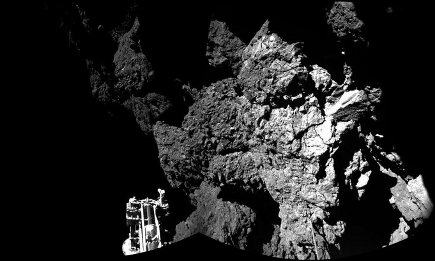Oogst van een komeet

In Nature geven de onderzoekers hun eerste indrukken en zien uit naar het vele werk en R&D die hen nu te wachten staat. “The first panoramic pictures from its CIVA (Comet Nucleus Infrared and Visible Analyser) camera show a surface covered in dust and debris, with rock-like materials in a range of sizes. “It’s certainly rougher than what we thought,” says Stephan Ulamec, Philae project manager at the German Aerospace Center (DLR) near Cologne.
Hard ijs
Data from another instrument, MUPUS (Multi-purpose Sensors for Surface and Sub-Surface Science), which includes a Coke-can-sized hammer mechanism atop a 40-centimetre-long rod to probe the comet’s surface, revealed a surprise: the comet seems to have hard ice underneath a 10–20-centimetre layer of dust, into which the hammer could not probe. “We were expecting a softer layer, with a consistency like compact snow, or maybe chalk,” says the DLR’s Tilman Spohn, principal investigator for MUPUS.”
Extra data
Dat Philae pas na een reeks sprongen vaste voet op komeet Chury vond, blijkt achteraf een bonus voor de wetenschap. Nu is veel meer nieuw inzicht in bijvoorbeeld het magnetisme van dit hemellichaam mogelijk geworden. “Another instrument on the lander, ROMAP (Rosetta Magnetometer and Plasma Monitor), probably benefited from Philae’s two bounces. ROMAP will help to answer whether the comet has its own magnetic field — which could have ramifications for models of planet formation — and how the ionized gas that envelops the comet changes near its surface; the bounces mean extra data points. “If someone designed a mission for magnetometers, and he was a very creative person, he would have done it exactly like that,” says Uli Auster, ROMAP’s co-principal investigator.”
Boren en snuffelen
De eerste snuffels van Philae aan het oppervlakte van de komeet hebben dat opgeleverd waar vele astronomen op aasden. Het Sinterklaasgevoel van astrobioloog Inge Loes ten Kate van de UU lijkt al vast met een wel heel bijzonder presentje in haar schoen te zijn beloond. “Shortly after touchdown, organic molecules were detected in samples of the comet’s surface, courtesy of COSAC, the Cometary Sampling and Composition experiment. It is designed to probe for such molecules and test whether their handedness, or chirality, matches with chemical signatures on Earth.’
“COSAC had to wait until the final hours of Philae’s battery life before attempting to probe the sub-surface because of fears that the drill action would cause the unanchored lander to tip over. After mission control finally gave the signal to bore down, Philae was able to send back data, which the COSAC team are now scouring for molecules, says co-investigator Uwe Meierhenrich, an analytical chemist at the University of Nice Sophia Antipolis in France.”
U leest hier op Nature de uitvoerige impressies van de eerste data van Philae.
Meest Gelezen
Vrouwen houden universiteit draaiende, maar krijgen daarvoor geen waardering
Hbo-docent wil wel rolmodel zijn, maar niet eigen moreel kompas opdringen
Wederom intimidatie van journalisten door universiteit, nu in Delft
‘Waarom het nu niet lukt om medezeggenschap in hbo te versterken’
‘Sluijsmans et al. slaan de plank volledig mis’
